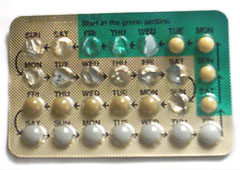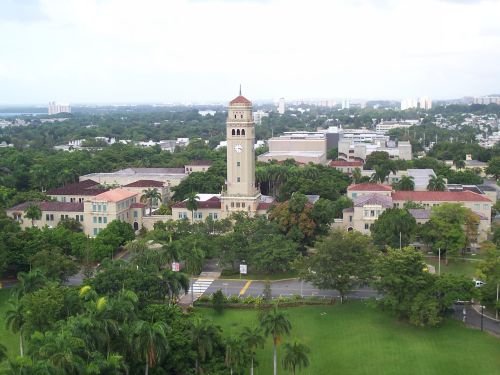|
Contraceptive Trials In Puerto Rico
The first large-scale human trial of the birth control pill was carried out in Puerto Rico in the 1950s. Between conceptualization and legalization of the first birth control drug in the United States in 1960, there were many developments and trials of test drugs. One such trial happened in Puerto Rico in the 1950s. Before the drug was approved as safe in the mainland U.S., many Puerto Rican women were used as test subjects. The trials were conducted by Gregory Pincus and John Rock (American scientist), John Rock in 1955. These trials are a major component in the history of the development of female oral contraceptives, occurring in between initial small trial testing on the east coast and the release of the drug for public consumption. American testing surrounding the Puerto Rico trials In the 1873, the United States Government passed a series of legislation commonly known as the Comstock Laws. The Comstock Laws not only criminalized the use of the postal service as a means of ... [...More Info...] [...Related Items...] OR: [Wikipedia] [Google] [Baidu] |
Birth Control Pill
The combined oral contraceptive pill (COCP), often referred to as the birth control pill or colloquially as "the pill", is a type of birth control that is designed to be taken orally by women. The pill contains two important hormones: progestin (a synthetic form of the hormone progestogen/progesterone) and estrogen (usually ethinylestradiol and 17β estradiol). When taken correctly, it alters the menstrual cycle to eliminate ovulation and prevent pregnancy. COCPs were first approved for contraceptive use in the United States in 1960, and are a very popular form of birth control. They are used by more than 100 million women worldwide and by about 9 million women in the United States. From 2015 to 2017, 12.6% of women aged 15–49 in the US reported using COCPs, making it the second most common method of contraception in this age range (female sterilization is the most common method). Use of COCPs, however, varies widely by country, age, education, and marital status. For exam ... [...More Info...] [...Related Items...] OR: [Wikipedia] [Google] [Baidu] |
Progesterone
Progesterone (P4) is an endogenous steroid and progestogen sex hormone involved in the menstrual cycle, pregnancy, and embryogenesis of humans and other species. It belongs to a group of steroid hormones called the progestogens and is the major progestogen in the body. Progesterone has a variety of important functions in the body. It is also a crucial metabolic intermediate in the production of other endogenous steroids, including the sex hormones and the corticosteroids, and plays an important role in brain function as a neurosteroid. In addition to its role as a natural hormone, progesterone is also used as a medication, such as in combination with estrogen for contraception, to reduce the risk of uterine or cervical cancer, in hormone replacement therapy, and in feminizing hormone therapy. It was first prescribed in 1934. Biological activity Progesterone is the most important progestogen in the body. As a potent agonist of the nuclear progesterone receptor (nPR) ... [...More Info...] [...Related Items...] OR: [Wikipedia] [Google] [Baidu] |
Health In Puerto Rico
Health, according to the World Health Organization, is "a state of complete physical, mental and social well-being and not merely the absence of disease and infirmity".World Health Organization. (2006)''Constitution of the World Health Organization''– ''Basic Documents'', Forty-fifth edition, Supplement, October 2006. A variety of definitions have been used for different purposes over time. Health can be promoted by encouraging healthful activities, such as regular physical exercise and adequate sleep, and by reducing or avoiding unhealthful activities or situations, such as smoking or excessive stress. Some factors affecting health are due to individual choices, such as whether to engage in a high-risk behavior, while others are due to structural causes, such as whether the society is arranged in a way that makes it easier or harder for people to get necessary healthcare services. Still, other factors are beyond both individual and group choices, such as genetic disorders. H ... [...More Info...] [...Related Items...] OR: [Wikipedia] [Google] [Baidu] |
Food And Drug Administration
The United States Food and Drug Administration (FDA or US FDA) is a List of United States federal agencies, federal agency of the United States Department of Health and Human Services, Department of Health and Human Services. The FDA is responsible for protecting and promoting public health through the control and supervision of food safety, tobacco products, caffeine products, dietary supplements, Prescription drug, prescription and Over-the-counter drug, over-the-counter pharmaceutical drugs (medications), vaccines, biopharmaceuticals, blood transfusions, medical devices, electromagnetic radiation emitting devices (ERED), cosmetics, Animal feed, animal foods & feed and Veterinary medicine, veterinary products. The FDA's primary focus is enforcement of the Federal Food, Drug, and Cosmetic Act (FD&C), but the agency also enforces other laws, notably Section 361 of the Public Health Service Act, as well as associated regulations. Much of this regulatory-enforcement work is not d ... [...More Info...] [...Related Items...] OR: [Wikipedia] [Google] [Baidu] |
Birth Control In The United States
Birth control is a method or device used to prevent pregnancy. Birth control has been around since ancient times, but effective and safe forms of birth control have only become available in the 20th century. According to the 2015–2017 National Survey of Family Growth conducted on 72.2 million women between the ages of 15 and 49 in the United States, approximately 64.9% of the sample reported using some method of birth control. There is a complicated and long history regarding birth control in the United States, in addition to several of the most prominent policies and laws regarding their use. History Birth control before 20th century The practice of birth control was common throughout the U.S. prior to 1914, when the movement to legalize contraception began. Longstanding techniques included the rhythm method, withdrawal, diaphragms, contraceptive sponges, condoms, prolonged breastfeeding, and spermicides. Use of contraceptives increased throughout the nineteenth century ... [...More Info...] [...Related Items...] OR: [Wikipedia] [Google] [Baidu] |
Clinical Trials
Clinical trials are prospective biomedical or behavioral research studies on human participants designed to answer specific questions about biomedical or behavioral interventions, including new treatments (such as novel vaccines, drugs, dietary choices, dietary supplements, and medical devices) and known interventions that warrant further study and comparison. Clinical trials generate data on dosage, safety and efficacy. They are conducted only after they have received health authority/ethics committee approval in the country where approval of the therapy is sought. These authorities are responsible for vetting the risk/benefit ratio of the trial—their approval does not mean the therapy is 'safe' or effective, only that the trial may be conducted. Depending on product type and development stage, investigators initially enroll volunteers or patients into small pilot studies, and subsequently conduct progressively larger scale comparative studies. Clinical trials can vary i ... [...More Info...] [...Related Items...] OR: [Wikipedia] [Google] [Baidu] |
La Operación
''La Operación'' is a forty-minute documentary film by Ana María García Ana María García is a Cuban-Puerto Rican film director. She is best known for the short documentary '' La Operación'' (1982) a film which focuses on US-imposed sterilization policies in Puerto Rico. She produced the documentar''Cocolos y Ro ... about US-imposed sterilization policies in Puerto Rico. Produced by the Latin American Film Project and released in 1982, this film explores the mass sterilization of Puerto Rican women during the 1950s and 1960s. In the documentary, Garcia sheds light on the decades-long practice by conducting interviews with women of different ethnic and economic backgrounds who have undergone the sterilization procedure. In addition to these interviews, Garcia provides historical information regarding the conditions that led to the sterilization practice. Historical background Beginning with the Spanish American War of 1898, the film details the origin and subsequen ... [...More Info...] [...Related Items...] OR: [Wikipedia] [Google] [Baidu] |
Angela Davis
Angela Yvonne Davis (born January 26, 1944) is an American political activist, philosopher, academic, scholar, and author. She is a professor at the University of California, Santa Cruz. A feminist and a Marxist, Davis was a longtime member of the Communist Party USA (CPUSA) and is a founding member of the Committees of Correspondence for Democracy and Socialism (CCDS). She is the author of more than ten books on class, gender, race, and the U.S. prison system. Born to an African-American family in Birmingham, Alabama, Davis studied French at Brandeis University and philosophy at the University of Frankfurt in West Germany. Studying under the philosopher Herbert Marcuse at the Frankfurt School, Davis became increasingly engaged in far-left politics. Returning to the United States, she studied at the University of California, San Diego, before moving to East Germany, where she completed a doctorate at the Humboldt University of Berlin. After returning to the United States, sh ... [...More Info...] [...Related Items...] OR: [Wikipedia] [Google] [Baidu] |
Río Piedras, Puerto Rico
Río Piedras is a populous district of San Juan, and former town and municipality of Puerto Rico, which was merged with the municipality of San Juan in 1951. The district today is composed of various '' barrios'' (these are the primary legal divisions of municipalities in Puerto Rico) such as Pueblo and Universidad. The historic town was founded in 1714 as El Roble, it was given municipality rights in 1823, and since 1903 it has been the home of the University of Puerto Rico's main campus, earning the popular name of ''Ciudad Universitaria'' (similar to college town) today. The downtown and historic center of Río Piedras is officially known as the Pueblo barrio of the municipality of San Juan. Name In addition to being the name of the barrio and district, Río Piedras ( Piedras River) is also the name of a river that crosses the district. Río Piedras was also the name of the former municipality of Puerto Rico (1823-1950). History The area where Río Piedras is lo ... [...More Info...] [...Related Items...] OR: [Wikipedia] [Google] [Baidu] |
Estrogen
Estrogen or oestrogen is a category of sex hormone responsible for the development and regulation of the female reproductive system and secondary sex characteristics. There are three major endogenous estrogens that have estrogenic hormonal activity: estrone (E1), estradiol (E2), and estriol (E3). Estradiol, an estrane, is the most potent and prevalent. Another estrogen called estetrol (E4) is produced only during pregnancy. Estrogens are synthesized in all vertebrates and some insects. Their presence in both vertebrates and insects suggests that estrogenic sex hormones have an ancient evolutionary history. Quantitatively, estrogens circulate at lower levels than androgens in both men and women. While estrogen levels are significantly lower in males than in females, estrogens nevertheless have important physiological roles in males. Like all steroid hormones, estrogens readily diffuse across the cell membrane. Once inside the cell, they bind to and activate estrogen receptors (E ... [...More Info...] [...Related Items...] OR: [Wikipedia] [Google] [Baidu] |
Gregory Pincus
Gregory Goodwin Pincus (April 9, 1903 – August 22, 1967) was an American biologist and researcher who co-invented the combined oral contraceptive pill. Early life Gregory Goodwin Pincus was born in Woodbine, New Jersey to Jewish parents, who were immigrants from the Russian Empire. His father was Joseph Pincus, a teacher and the editor of a farm journal, and his mother was Elizabeth (née Lipman), whose family had come from the region that is now Latvia. He credited two uncles, both agricultural scientists, for his interest in research. His IQ was said to be 210 and his family considered him a genius. Pincus attended Cornell University and received a bachelor's degree in biology in 1924. He attended Harvard University, where he was an instructor in zoology while also working toward his master's and doctorate degrees. From 1927 to 1930 he moved from Harvard to Cambridge University in England to the Kaiser Wilhelm Institute for Biology with Richard Goldschmidt in Berlin where he ... [...More Info...] [...Related Items...] OR: [Wikipedia] [Google] [Baidu] |
.jpg)



.jpg)

.jpg)


